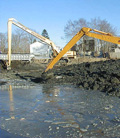Water: Contaminated Sediments
How to Locate







Water pollution is a significant problem in the United States. In the 1970s, a host of measures were taken to improve water quality, including bans on the use of DDT and PCBs. Major water quality legislation in the 1970s included the Federal Water Quality Pollution Control Act Amendments of 1972 and the Clean Water Act (CWA) of 1977. Water quality began to improve, but by the early 1980s scientists realized that many toxic contaminants remained in sediments and that they could be resuspended by storms, ships, or even passing aquatic animals.
In 1985 and 1987, the EPA Office of Water began to document the extent and severity of sediment contamination. Surveys showed that the types and levels of contamination varied greatly at sites throughout the country.
More recently, under the Water Resources Development Act of 1992 (WRDA), Congress directed EPA—in consultation with the National Oceanic and Atmospheric Administration (NOAA) and the Secretary of the Army—to conduct a comprehensive national survey of data on sediment quality. In response, EPA undertook the National Sediment Quality Survey (NSQS), a compilation of data on sediment quality.
EPA submitted to Congress its first survey report on sediment contamination in 1998. The survey found that there is contaminated sediment in all regions and every state. The affected water bodies include streams, lakes, harbors, near-shore areas, and oceans. Some of the most contaminated sediments are found in the Great Lakes and in the harbors of Boston, Los Angeles, Chicago, Detroit, and Puget Sound. All of these water bodies have been impacted throughout the years by heavy shipping traffic, contamination from upstream sources, and local municipal and industrial discharges.Although the NSQS is an important step in the identification and analysis of contaminated sediments, the study does have its limits. For example, many of the data in the inventory were collected before experts had identified all of the important factors that affect sediment contamination.
Today, scientists realize that the size of a sediment grain, the amount of organic carbon in the sediment, and other characteristics determine the bioavailability of contaminants. Unfortunately, this important information is not always available in historical sediment data. EPA believes that better data on sediment quality and direct measurements of chemical concentrations in edible fish tissue are needed. Efforts to gather this information are underway.
EPA's Environmental Monitoring and Assessment Program (EMAP), NOAA's National Status and Trends Program, and EPA's Great Lakes National Program Office are among the programs monitoring sediments more comprehensively. They are collecting data on the physical and chemical characteristics of sediments, the bioavailability of contaminants, levels of contaminant residues in the tissues of aquatic organisms, and the health of benthic communities.
Even if toxic chemicals and metals are present in sediments, they may not be harmful. Bioavailablity is a measure of how likely it is that the contaminants will actually affect living organisms. Many factors affect the bioavailability of contaminants. These factors include the acidity/alkalinity of the water and the presence or absence of sulfur in the sediment.
To assess the ecological and human health risks posed by contaminated sediments at a site, it is not enough to measure the types and amounts of pollutants present. Scientists may conduct field surveys to assess the health of benthic communities and the levels of contaminants found in the resident fish species. They may run chemical tests to assess the factors that affect bioavailability, and often times conduct biological tests by actually exposing benthic organisms to the contaminated sediment and observing the results.

